英语人教版八年级上册U3复习课教学设计
八年级上unit3复习课教学设计
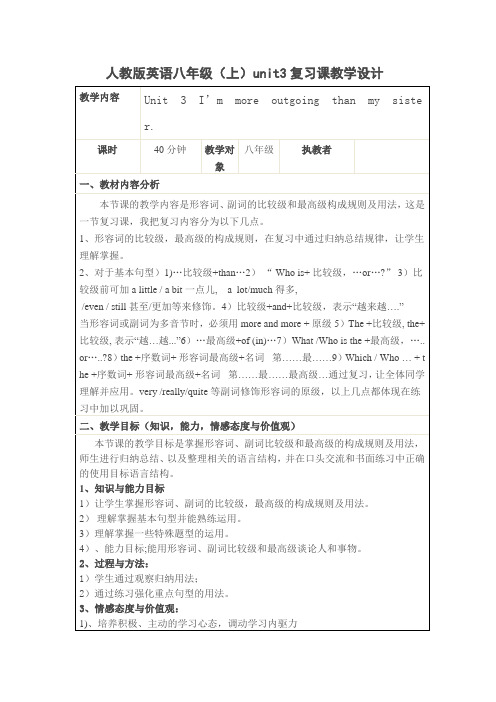
八、总结和帮助(反思及改进)
时间安排有点前松后紧,最后的写作没时间完成。课本词组及句子可口头完成,比较级及最高级的练习应给于足够的时间练习。
七、作业布置
A: Dictate the expressions in this unit.
B: Write a passage about
“My good friend and I ”
Write about the things that are different between you and your friend.
五、资源准备
多媒体
设计意图
及资源准备
Task1
Task 2
Task 3
Task 4
Task5
Writing
1、Have Ss review the useful expressions
2 Have Ss complete the sentences.
3.形容词、副词的比较级和最高级构成规则:
/even / still甚至/更加等来修饰。
3)比较级+and+比较级,表示“越来越….”
当形容词或副词为多音节时,必须用
more and more +原级
4)The +比较级,the+比较级,表示“越…越...”
5)Who / Which…+比较级,A or B?
3.Ss do some exercises.
1. Ss talk about the pictures,
Then write a passage.
人教版英语八年级上册Unit3SectionA(GrammarFocus)教学设计
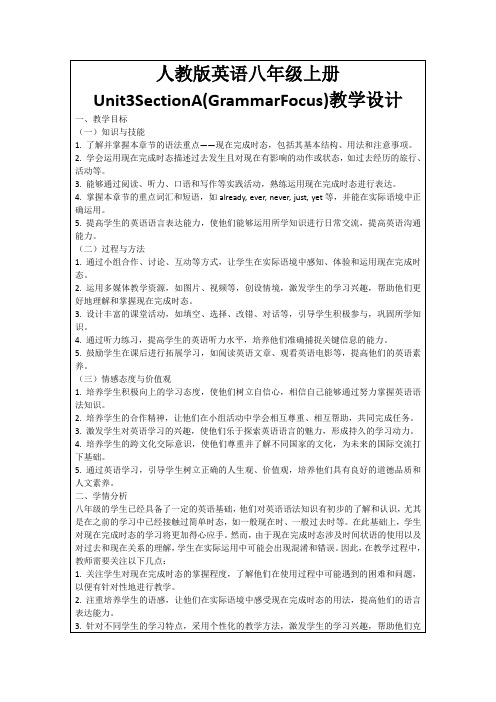
1.培养学生积极向上的学习态度,使他们树立自信心,相信自己能够通过努力掌握英语语法知识。
2.培养学生的合作精神,让他们在小组活动中学会相互尊重、相互帮助,共同完成任务。
3.激发学生对英语学习的兴趣,使他们乐于探索英语语言的魅力,形成持久的学习动力。
4.培养学生的跨文化交际意识,使他们尊重并了解不同国家的文化,为未来的国际交流打下基础。
四、教学内容与过程
(一)导入新课
1.教学活动设计:教师以一个有关旅行的故事引入新课,通过讲述故事中人物的旅行经历,引导学生关注故事中使用的现在完成时态句子。如:“They have already visited the Great Wall.”、“Has she ever been to Hainan?”等。
4.掌握本章节的重点词汇和短语,如already, ever, never, just, yet等,并能在实际语境中正确运用。
5.提高学生的英语语言表达能力,使他们能够运用所学知识进行日方法
1.通过小组合作、讨论、互动等方式,让学生在实际语境中感知、体验和运用现在完成时态。
5.通过英语学习,引导学生树立正确的人生观、价值观,培养他们具有良好的道德品质和人文素养。
二、学情分析
八年级的学生已经具备了一定的英语基础,他们对英语语法知识有初步的了解和认识,尤其是在之前的学习中已经接触过简单时态,如一般现在时、一般过去时等。在此基础上,学生对现在完成时态的学习将更加得心应手。然而,由于现在完成时态涉及时间状语的使用以及对过去和现在关系的理解,学生在实际运用中可能会出现混淆和错误。因此,在教学过程中,教师需要关注以下几点:
b.学生在小组内进行讨论,分享自己的观点和看法。
c.每个小组汇报讨论成果,教师进行点评和指导。
Unit 3 复习课教学设计 人教版英语八年级上册

Unit 3 I am more outgoing than my sister?Revision教学设计ⅠAnalysis of the teaching materialThis part is mainly about personal traits and how to compare people.ⅡAnalysis of the teaching aimsⅢTeaching key and difficult pointsing different dimensions to introduce and compare friendsing comparative to discuss and compare character characteristics.ⅣTeaching aids: SeewoⅤTeaching methods: Situational approach, task-based approach, inspirational teachingⅥTeaching procedure(标注中ABC分别代表不同层次的学生,A层较好,B层中等,C层为学困生) TeachingprocedureTeacher’s activities Ss’s activities purposeStep 1Lead-in(ABC)1.Greeting and show thelearning objectives2.A brief introductionabout Xiong Chumo3.Let Ss chant and playgames1.Read and know thelearning objectives2.Watch a short videoabout Xiong Chumo3.Chant and play games1.To introduce the maincharacter of this class andcreate a situation of this class2.Review the rules for thecomparative change ofadjectives and adverbStep 2 Presentation (AB)Present a question and listthe dimensions ofintroducing a friendThink and answer thequestionsEnable students to have acomprehensive understandingof the dimensions ofintroducing friendsStep 3 Appearance (ABC)Present a picture ofXiong Da, Xiong Er andGuang Touqiang and aska questionDescribe and compare twocharacters of the three inappearancePractice positive degree andcomparative sentencestructuresStep 4 Personality (AB)Show some pictures andpresent a questionDescribe and compare twocharacters of the three inpersonalityReview and practice positivedegree and comparativesentence structuresStep 5 Ability (AB)Show some pictures andphrases, present aquestionDescribe and compare twocharacters of the three inabilityTo help Ss understand thedifferences among peopleStep 6 Ask them to do some Discuss and share the Further expansion of theⅦ。
人教版八年级英语上册Unit3unit4语法复习教学设计

(3)针对情态动词的用法,采用对比分析法,帮助学生区分不同情态动词的用法,并总结规律。
(二)教学设想
1.导入:通过提问方式引导学生回顾Unit3和Unit4的学习内容,为新课的学习做好铺垫。
2.呈现与讲解:
(1)利用网络资源,查找与语法相关的学习资料,进行自主学习,提高语法素养。
(2)总结本节课所学语法知识,制作成思维导图,帮助记忆和理解。
5.小组合作作业:
(1)分组讨论,共同完成一份语法知识总结报告,要求涵盖本节课的所有知识点。
(2)开展小组间的语法知识竞赛,互相提问、解答,提高团队合作能力。
注意事项:
八年级学生在经过一年的英语学习后,已经具备了一定的英语基础,对基本的语法知识有了一定的了解。然而,由于个体差异,学生在语法知识掌握程度、学习兴趣和动机方面仍存在一定的差异。在本章节的教学中,我们需要关注以下几点:
1.学生在Unit3和Unit4中已经接触过一般将来时、现在进行时、一般过去时等语法知识点,但部分学生在实际运用中仍存在困难,需要通过复习加强巩固。
1.情境教学法:通过设计真实语境,让学生在实际交流中复习和巩固语法知识。
2.任务型教学法:设置各种任务,引导学生运用所学语法知识解决问题,提高学生的实践能力。
3.合作学习法:鼓励学生进行小组讨论、交流,培养学生的团队协作能力和沟通能力。
4.激励性评价:对学生的每一次发言和作业给予积极评价,激发学生的学习兴趣和自信心。
2.教学目的:帮助学生掌握语法知识,提高在实际语境中正确运用语法的能力。
3.教学方法:采用讲解法、演示法,结合多媒体教学手段,使学生对语法知识有更直观的理解。
人教版八年级英语上册 Unit 3 复习教案
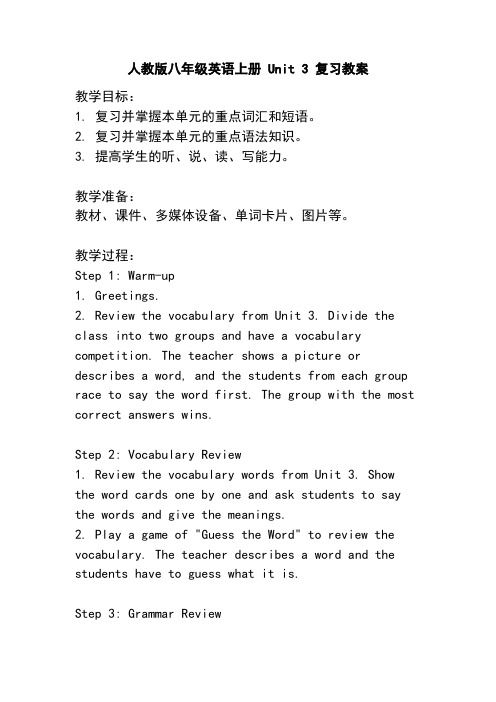
人教版八年级英语上册 Unit 3 复习教案教学目标:1. 复习并掌握本单元的重点词汇和短语。
2. 复习并掌握本单元的重点语法知识。
3. 提高学生的听、说、读、写能力。
教学准备:教材、课件、多媒体设备、单词卡片、图片等。
教学过程:Step 1: Warm-up1. Greetings.2. Review the vocabulary from Unit3. Divide the class into two groups and have a vocabulary competition. The teacher shows a picture or describes a word, and the students from each group race to say the word first. The group with the most correct answers wins.Step 2: Vocabulary Review1. Review the vocabulary words from Unit 3. Show the word cards one by one and ask students to say the words and give the meanings.2. Play a game of "Guess the Word" to review the vocabulary. The teacher describes a word and the students have to guess what it is.Step 3: Grammar Review1. Review the present continuous tense. Use examples and pictures to elicit the rules of forming and using the present continuous tense.2. Give students a worksheet with sentences in the present continuous tense. Have them complete the sentences by filling in the correct form of the verb in brackets.3. Play a game of "What are they doing?" Show pictures of different activities and ask students to describe what the people are doing using the present continuous tense.Step 4: Listening and Speaking Practice1. Play the recording of the dialogue from Unit 3 and have students listen and answer the questions.2. Pair students up and give them a topic to discuss using the present continuous tense. For example, "What are you doing after school today?" Have them take turns asking and answering questions using the present continuous tense.Step 5: Reading and Writing Practice1. Have students read the passage from Unit 3 and answer the comprehension questions.2. Ask students to write a short paragraph about what they are doing at the moment using the present continuous tense.Step 6: Consolidation1. Review the key points of Unit 3 and ask students if they have any questions.2. Summarize the main grammar points and vocabulary words from the unit.Step 7: Homework1. Assign homework exercises from the textbook or workbook to reinforce the grammar and vocabulary learned in Unit 3.2. Encourage students to practice using the present continuous tense in their daily life and write down what they are doing at different times of the day.教学反思:本节课通过复习本单元的重点词汇和语法知识,巩固学生对所学内容的掌握。
人教版初中英语八年级上册Unit 3 教案
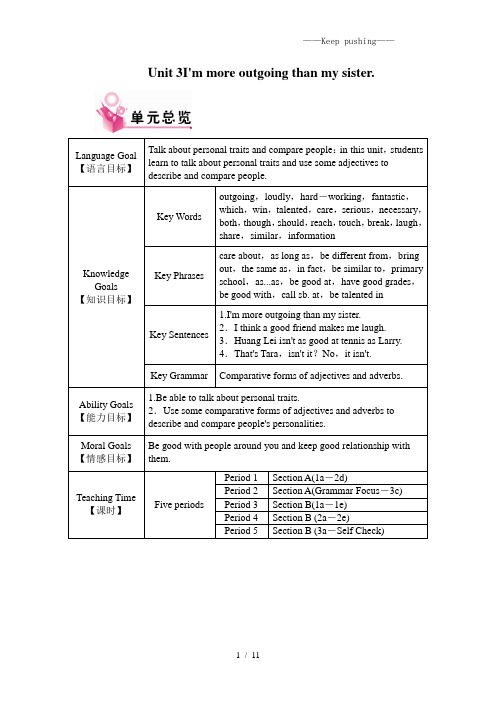
Unit 3I'm more outgoing than my sister.Section A是基本的语言部分,打好本单元目标语言的基础。
运用听力(1b,2a,2b)、pair-work(1c,2c)、role-play (2d)等口语练习活动,层层递进,步步深入,充分培养学生学习目标英语的语感。
目标语言(语法和词汇)是在每个单元的开始通过图片和对话框呈现的。
图片将帮助学生建立一个自然的语境,让学生清晰地理解新的语言目标,熟悉这些语言在日常生活中是怎样使用的。
Section B是比较级的拓展和综合的语言运用。
1a,1b通过讨论在朋友身上什么是最重要的,为后面提供基本句子如makes me laugh等。
1c,1d通过听力继续以朋友为话题以比较级为语法谈论朋友。
2b,3c是通过阅读和写作最后达到综合运用语言的目的,2b培养真实生活中的语言阅读技能。
4通过谈论谁是合适的student helper来继续巩固运用目标语言。
Self Check 2考查五个形容词的用法及区别形容词比较级与原级的使用。
Self Check 3运用比较级对比自己和好友。
第一课时Section A(1a-2d)Teaching Goals【教学目标】Key words:outgoing,better,loudly,quietly,hard-working,competition,fantastic,which,clearly,winKey phrases:play the drums,more...than,as...as,singing competition,have funKey sentences:1.I'm more outgoing than my sister.2. That's Tara,isn't it?No,it isn't.3. I think she sang more clearly than Nelly.Teaching Key Points【教学重点】The vocabulary:outgoing,better,loudly,quietly,hard-working,competition,fantastic,which,clearly,win,more...than,as...asTarget language:,that's Tom.Sam has longer hair than Tom.—That's Tara,isn't it?—No,it isn't.It's Tina.Tina is taller than Tara.And she also sings more loudly than Tara.—Did you like the singing competition yesterday,Anna?—Oh,it was fantastic!Nelly sang so well!Is Tom smarter than Sam?Teaching Difficult Points【教学难点】Oral practice using the target language above.Teaching Aids【教学工具】An English textbook,a tape recorder,CAI or courseware.Teaching Steps【教学过程】★Step 1Leading inAsk a student to introduce herself/himself.★Step 2Pre-taskPage 17,1a.1.Show some pictures to Ss.Say,They are stars.Ask Ss to tell what they see.Ask Ss to use the words:tall,loudly,thin,long hair,short hair,heavy,quietly,short and so on.2.Then ask Ss to repeat these sentences:Yao Ming is taller than Ronaldo.★Step 3While-taskPage 17,1c & 1b.1.Call attention to the picture.2.Point out the sample conversation in Activity 1c.Say,Now work with a partner.Make your own conversation about the twins.3.Ask several pairs to say one or more of their conversations.4.Then listen to the recording.Ask Ss to number the twins.5.Check the answers.Page 18,2a.1.Point out the two columns and read the headings:-er,-ier and more.Then point out the words in the box.Read.Say,Now listen and write the“-er”and“-ier”words in the first column and the words that use“more”in the second column.2.Play the recording and check the answers.Page 18,2b.1.Point out the picture and the two boxes with the headings Tina and Tara.Say,Listen to the recording.Write sentences in the boxes.2.Play the recording and check the answers.★Step 4Post-taskPage 18,2c & 2d.1.Point out the chart in Activity 2c and on Page 81.Say,Make your own conversations according to the information.Ask pairs to continue on their own.2.Correct the answers.3.Make students scan the conversation in 2d.4.Teach and then make Ss role-play the conversation in pairs.In this part,student A will be Julie.Student B will be Anna.As they talk,move around to monitor their work.Offer language or pronunciation support as needed.5.Have a group of students present their conversation to the class.★Step 5Homework1.How are you and your sister/brother different?Write down.2.Do the exercises on Page 15 in students' book.Board Design板书设计Unit 3I'm more outgoing than my sister.The first periodSection A(1a-2d)1.Words:outgoing,better,loudly,quietly,hard-working,competition,fantastic,which,win,clearly2.Target language:①A:That's Tara,isn't it?B:No,it isn't.②A:Is Tom smarter than Sam?B:No,he isn't.Sam is smarter than Tom.第二课时Section A(GF-3c)Teaching Goals【教学目标】Key sentences:1.Is Tara more outgoing than Tina?No,she isn't.Tina is more outgoing than Tara.2.Does Tara work as hard as Tina?Yes,she does.3.Who is smarter,your mother or your father?I think my mother is smarter than my father.Teaching Key Points【教学重点】1.Grammar Focus.The sentences in the box.2.The comparative forms of adjectives and adverbs.Teaching Difficult Points【教学难点】1.The comparative forms of adjectives and adverbs.2.Use some adjectives to describe people and use their comparative forms to compare people.Teaching Aids【教学工具】An English textbook,CAI or courseware.Teaching Steps【教学过程】★Step 1Leading inAsk,How are you and your mother/father different?Ask some Ss to answer.★Step 2Pre-taskPage 19,Grammar Focus.1.Review the grammar box.Ask Ss to read the sentences to the class.2.Write the phrases“more outgoing than”.Say,When you compare things using words with three or more syllables,you use the word “more”.3.Call attention to the word“friendly”,circle“y”and say,When a word ends in“y”,change“y”to an“i”and add“-er”.4.Practice reading the sentences in the chart.★Step 3While-taskPage 19,3a & 3b.1.Call students' attention to 3a.2.Make students complete the tasks individually.3.Choose Ss to give their answers.4.Correct the answers.5.Practice reading.6.Turn to 3b.And choose a student to answer the five questions according to the example.★Step 4Post-taskPage 19,3c.1.Ask students to read the sample conversation in the box.2.Have students work in pairs to complete the chart.3.Ask some pairs to present their dialogues.★Step 5Homework1.Compare one of your best friends with you.Write down the same and different things between you two.2.Do the exercises on Page 16 in students' book.Board Design板书设计Unit 3I'm more outgoing than my sister.The second periodSection A(GF-3c)1.Target language:①A:Is Tara more outgoing than Tina?B:No,she isn't.Tina is more outgoing than Tara.②A:Are you as friendly as your sister?B:No,I'm not.I'm friendlier.③A:Does Tara work as hard as Tina?B:Yes,she does.④A:Who is smarter,your mother or your father?B:I think my mother is smarter than my father.2.Answers to 3a.第三课时Section B(1a-1e)Teaching Goals【教学目标】Key words & phrases:talented,truly,care,be talented in,the same as,be good at,care about,make ughKey sentences:1.I think a good friend makes me laugh.2.Molly studies harder than her best friend.Teaching Key Points【教学重点】The vocabulary:talented,care,care about,be talented inTarget language:I think a good friend makes me laugh.For me,a good friend likes to do the same things as me.Yes,and a good friend is talented in music,too.That's not very important for me...Molly studies harder than her best friend.Well,Mary and her best friend are both tall.Teaching Difficult Points【教学难点】Use the target language to talk with your classmates about your opinions on what makes a good friend.Teaching Aids【教学工具】An English textbook,a tape recorder,CAI or courseware.Teaching Steps【教学过程】★Step 1Leading in1.Show a maxim to Ss:A friend in need is a friend indeed.2.Ask,What kinds of things are important in a friend?★Step 2Pre-taskPage 20,1a.1.Read each description to the class and ask the Ss to repeat.2.What kinds of things are important in a friend?Rank the things below 1—7(1 is the most important).3.Ask different Ss to copy the seven phrases on the board.Then read the phrases together.★Step 3While-taskPage 20,1b.1.Say,Now make your own statements about friends using the phrases in Activity 1a.2.Ask some Ss to tell the class what they look for in a friend.And say,Who is your best friend?Page 20,1c.Play the recording and check the answers.Page 20,1d.Play the recording and check the answers.★Step 4Post-taskPage 20,1e.1.Say,Now work with your partner.Make a conversation using information in the chart.2.Ask several pairs to say their conversations to the class.★Step 5HomeworkDo the exercises on Page 17 in students' book.Board Design板书设计Unit 3I'm more outgoing than my sister.The third periodSection B(1a-1e)1.Key vocabulary:truly,be talented in,the same as,be good at,care about,make ugh2.Target language:A:Molly studies harder than her best friend.B:Well,Mary and her best friend are both tall.第四课时Section B(2a-2e)Teaching Goals【教学目标】Key words:serious,mirror,kid,necessary,both,though,grade,should,saying,reach,hand,touch,heart,fact,break,arm,laugh,share,loud,similar Key phrases:as long as,be different from,bring out,the same as,care about,in fact,be similar toKey sentences:1.I'm quieter and more serious than most kids.2.I don't really care if my friends are the same as me or different.3.Huang Lei isn't as good at tennis as Larry.4.A true friend reaches for your hand and touches your heart.Teaching Key Points【教学重点】The vocabulary:serious,necessary,both,though,should,reach,touch,break,laugh,share,loud,similar,as long as,be different from,the same as,in fact,be similar toTarget language:I'm quieter and more serious than most kids.That's why I like reading books and study harder in class.In fact,she's funnier than anyone I know.I know she cares about me because she's always there to listen.Teaching Difficult Points【教学难点】Talk about the famous sayings about friends.Teaching Aids【教学工具】An English textbook,CAI or courseware.Teaching Steps【教学过程】★Step 1Leading in1.Greetings.2.Ask,Should friends be the same or different?Choose 2 or 3 students to talk about their opinions.Say,Today we'll read about what these people think.★Step 2Pre-taskPage 21,2a & 2b.1.Project some famous sayings about friendship on the screen.Ask Ss to guess their meanings and think of more.2.Project these new words on the screen or write them on the board and teach the new words.Ask students to repeat them.And make sure everyone knows the meanings.serious adj.严肃的;mirror n.镜子;necessary adj.必需的;both adj. & pron.两个;though adv.不过,可是conj.虽然;should modal v.应该;reach v.到达;touch v.感动,触摸;fact n.事实;break v.(使)破;laugh v.笑;share v.分享;similar adj.类似的;as long as只要;be different from 与……不同;bring out 使显现;the same as和……相同;in fact事实上;be similar to与……相像的3.Make students scan the three articles first.Ask students to put a mark in contents that are unfamiliar to them.Then the teacher lead Ss to learn them.Pay attention to the new words and phrases on the screen.4.Practice reading.★Step 3While-taskPage 22,2c & 2d.1.Make students read 2b again.Then judge if the eight statements in 2c are true(T)or false(F).2.Choose students to give their answers.3.Check the answers.4.Ask,How do you and your friends compare with the people in the article?Choose a student to talk about it with five sentences.★Step 4Post-taskPage 22,2e.1.Read the four sayings about friends.2.Talk about these questions with your partner:Which saying about friends is your favorite?Which friend do you think about when you read this saying?Why?Begin your statements according to the example:My favorite saying is...It makes me think about my best friend.She/He is...★Step 5Homework1.Search for five famous sayings about friends.Write them in your exercise books.2.Do the exercises on Page 18 in students' book.Board Design板书设计Unit 3I'm more outgoing than my sister.The fourth periodSection B(2a-2e)1.Words:serious,mirror,necessary,both,grade,should,saying,reach,hand,touch,fact,break,laugh,share,loud,similar2.Phrases:as long as,be different from,bring out,the same as,care about,in fact,be similar to3.Sentences:①I'm quieter and more serious than most kids.②Huang Lei isn't as good at tennis as Larry.③Friends are like books-you don't need a lot of them as long as they're good.④A true friend reaches for your hand and touches your heart.第五课时Section B(3a-Self Check)Teaching Goals【教学目标】Key words & phrases:primary,information,primary school,be good with,call sb.at,have good grades Key sentences:students.2.Call the English Study Center at 443-5667 for more information.3.So who do you think should get the job,Jenny or Jill?Teaching Key Points【教学重点】The vocabulary:information,primary school,have good grades,be good with,call sb.at...Teaching Difficult Points【教学难点】Writing practice.Teaching Aids【教学工具】An English textbook,CAI or courseware.Teaching Steps【教学过程】★Step 1Leading in1.Greetings.2.Check the homework.★Step 2Pre-taskPage 23,3a.1.Look at the pictures and the information in the chart.2.Compare Wang Lingling with Liu Lili.Write down the results.3.Choose a student to present his or her answers.★Step 3While-taskPage 23,3b & 3c.1.Complete the task in 3b.2.Write two paragraphs describing your friends using the notes you make in 3b.3.Choose 2 or 3 students to read their competitions loudly.4.Correct the mistakes.★Step 4Post-taskPage 24,Part 4.1.Write the names of two outgoing students on the board.Say,Who do you think should get the job,A or B?2.Ask Ss to work in pairs.3.Ask some pairs who they think should get the job and why.★Step 5ExercisePage 24,Self Check.1.Ask students to work on their own.2.Check the answers.★Step 6Homework1.Compare two of your best friends.Write five sentences using comparatives.2.Do the exercises on Page 19 in students' book.Board Design板书设计Unit 3I'm more outgoing than my sister.The fifth periodSection B(3a-Self Check)1.Key vocabulary:information,primary school,be good with,call sb.at+电话号码,have good grades2.Sentences:①Call the English Study Center at 443-5667 for more information.②Jenny is smarter,but I think Jill is more outgoing.11 / 11。
人教版八年级英语上册教案unit3 Unit 3教案

Unit 3 I’m more outgoing than my sister Teaching PlanI 教学内容、目标与要求II 教学内容分析本单元以描述某人的个性特征为中心而展开, 从外表和性格两方面比较人物之间的相同与不同点, 由此引出taller, shorter, thinner, longer, heavier, calmer, wilder, quieter, funnier, more athletic, more popular, more serious, more outgoing 等词汇, 以及“S + be + adj.比较级+than+被比较对象”这个重要的句子结构。
Section A部分重在要求听说读三个方面比较不同双胞胎之间外表和性格的区别, 附带着在3a也提出了as….as 结构the same as结构表达两人的相同之处。
与Section A部分比较, Section B 部分则深入到比较自己和朋友的相同与不同之处, 并提出了“选择朋友”这个话题, 引导学生正确评价朋友, 引导学生结识真正的好朋友。
III 教学过程建议围绕本单元“描述个性特征”这一话题,教师可以在课堂上展开系列的两人一组活动引出本单元的主要单词和句子结构“S + be + adj.比较级+than+被比较对象”。
如任务一:你眼里的我?学生两人一组展开活动,分别在各自的卡片上写下一些形容词,描述对方的身体和性格特点。
任务二:咱们相同吗?学生两人一组展开活动,通过比较各自的卡片,找出自己和对方相同的地方,简单地表述这些相同之处,然后进一步比较这些相同之处,说说它们在程度上的区别。
也可以准备一些教师自己或学生不同时期的照片,先用所学过的形容词描述照片,然后把两类照片进行比较,从而引出本单元所要讲的形容词的比较级。
本单元的听力练习教师可以根据学生的实际情况适当的扩展增加或降低难度。
在“说”方面,教师应尽量选择学生感兴趣的话题,激发学生开口交流。
人教版八年级上册英语Unit3单元复习教案
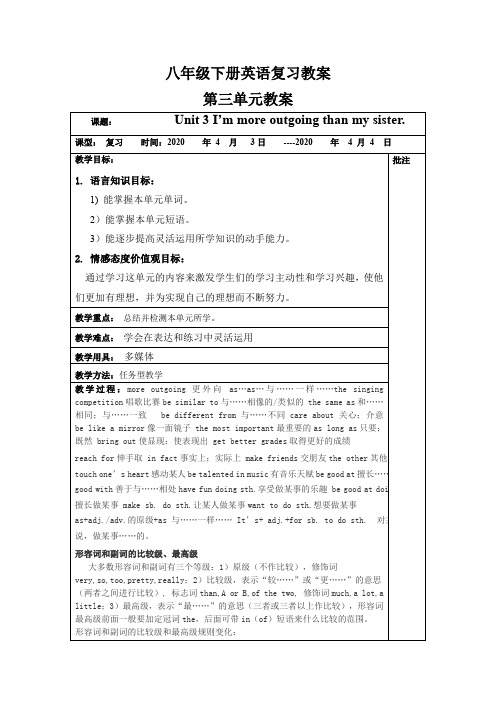
比较级
最高级
good/well
better
best
bad/badly
worse
worst
many/much
more
most
little
less
least
far
farther(更远)
further(更深远)
farthest(最远)
furthest(最深远)
as…(原级)as与……一样…… not as/so…as不如
通过学习这单元的内容来激发学生们的学习主动性和学习兴趣,使他们更加有理想,并为实现自己的理想而不断努力。
批注
教学重点:总结并检测本单元所学。
教学难点:学会在表达和练习中灵活运用
教学用具:多媒体
教学方法:任务型教学
教学过程:more outgoing更外向 as…as…与……一样……the singing competition唱歌比赛be similar to与……相像的/类似的 the same as和……相同;与……一致 be different from与……不同care about关心;介意 be like a mirror像一面镜子 the most important最重要的as long as只要;既然 bring out使显现;使表现出 get better grades取得更好的成绩
reach for伸手取 in fact事实上;实际上 make friends交朋友the other其他的
touch one’s heart感动某人be talented in music有音乐天赋be good at擅长…… be good with善于与……相处have fun doing sth.享受做某事的乐趣 be good at doing sth擅长做某事 make sb. do sth.让某人做某事want to do sth.想要做某事 as+adj./adv.的原级+as 与……一样…… It’s+ adj.+for sb. to do sth. 对某人来说,做某事……的。
八年级英语上册-人教版-Unit 3 教学设计(1)
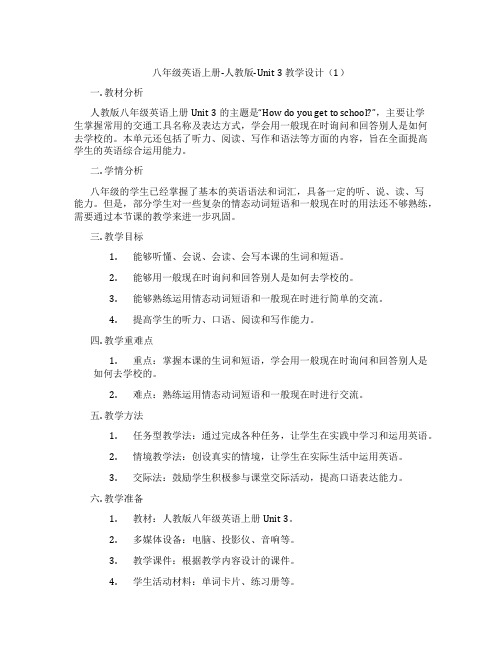
八年级英语上册-人教版-Unit 3 教学设计(1)一. 教材分析人教版八年级英语上册Unit 3的主题是“How do you get to school?”,主要让学生掌握常用的交通工具名称及表达方式,学会用一般现在时询问和回答别人是如何去学校的。
本单元还包括了听力、阅读、写作和语法等方面的内容,旨在全面提高学生的英语综合运用能力。
二. 学情分析八年级的学生已经掌握了基本的英语语法和词汇,具备一定的听、说、读、写能力。
但是,部分学生对一些复杂的情态动词短语和一般现在时的用法还不够熟练,需要通过本节课的教学来进一步巩固。
三. 教学目标1.能够听懂、会说、会读、会写本课的生词和短语。
2.能够用一般现在时询问和回答别人是如何去学校的。
3.能够熟练运用情态动词短语和一般现在时进行简单的交流。
4.提高学生的听力、口语、阅读和写作能力。
四. 教学重难点1.重点:掌握本课的生词和短语,学会用一般现在时询问和回答别人是如何去学校的。
2.难点:熟练运用情态动词短语和一般现在时进行交流。
五. 教学方法1.任务型教学法:通过完成各种任务,让学生在实践中学习和运用英语。
2.情境教学法:创设真实的情境,让学生在实际生活中运用英语。
3.交际法:鼓励学生积极参与课堂交际活动,提高口语表达能力。
六. 教学准备1.教材:人教版八年级英语上册Unit 3。
2.多媒体设备:电脑、投影仪、音响等。
3.教学课件:根据教学内容设计的课件。
4.学生活动材料:单词卡片、练习册等。
七. 教学过程1.导入(5分钟)利用课件展示一些交通工具的图片,引导学生谈论他们平时是如何去学校的。
2.呈现(5分钟)老师分别扮演不同的角色,用一般现在时询问和回答别人是如何去学校的,如:“How do you get to school?”“I usually go to school by bus.”等。
同时,板书生词和短语,如:bus, trn, usually, walk等。
英语人教版八年级上册Unit3 教学设计
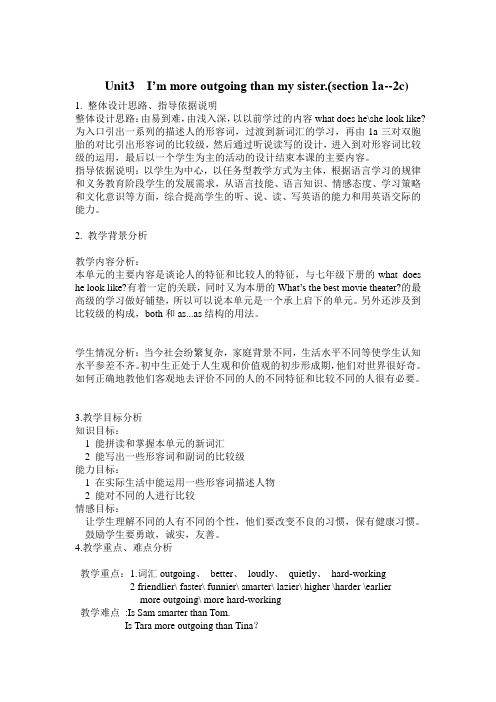
Unit3 I’m more outgoing than my sister.(section 1a--2c) 1. 整体设计思路、指导依据说明整体设计思路:由易到难,由浅入深,以以前学过的内容what does he\she look like?为入口引出一系列的描述人的形容词,过渡到新词汇的学习,再由1a三对双胞胎的对比引出形容词的比较级,然后通过听说读写的设计,进入到对形容词比较级的运用,最后以一个学生为主的活动的设计结束本课的主要内容。
指导依据说明:以学生为中心,以任务型教学方式为主体,根据语言学习的规律和义务教育阶段学生的发展需求,从语言技能、语言知识、情感态度、学习策略和文化意识等方面,综合提高学生的听、说、读、写英语的能力和用英语交际的能力。
2. 教学背景分析教学内容分析:本单元的主要内容是谈论人的特征和比较人的特征,与七年级下册的what does he look like?有着一定的关联,同时又为本册的What’s the best movie theater?的最高级的学习做好铺垫,所以可以说本单元是一个承上启下的单元。
另外还涉及到比较级的构成,both和as...as结构的用法。
学生情况分析:当今社会纷繁复杂,家庭背景不同,生活水平不同等使学生认知水平参差不齐。
初中生正处于人生观和价值观的初步形成期,他们对世界很好奇。
如何正确地教他们客观地去评价不同的人的不同特征和比较不同的人很有必要。
3.教学目标分析知识目标:1 能拼读和掌握本单元的新词汇2 能写出一些形容词和副词的比较级能力目标:1 在实际生活中能运用一些形容词描述人物2 能对不同的人进行比较情感目标:让学生理解不同的人有不同的个性,他们要改变不良的习惯,保有健康习惯。
鼓励学生要勇敢,诚实,友善。
4.教学重点、难点分析教学重点:1.词汇outgoing、better、loudly、quietly、hard-working2 friendlier\ faster\ funnier\ smarter\ lazier\ higher \harder \earliermore outgoing\ more hard-working教学难点:Is Sam smarter than Tom.Is Tara more outgoing than Tina?Does Tara work as hard as Tina?Both Sam and Tom can play the drums,but Sam plays them better thanTom5.教学过程设计步骤1:leading-in1.Greet the students.T:Hi,boys and girls.Ss:Hello, teacher,T:I feel very happy today because it is my third time to come here, I think Ganzhuo is a very beautiful city and people are kind and friendly.What do you think of people here?Ss:They are friendly\kind\brave\.....T:And what other adjectives can you use to describe people?Ss:Tall\short\thin\fat\heavy\long hair\short hair\of medium height\of medium build.. 2.让学生看屏幕,引出句型what’s he\she like?用图片引导学生复习句型。
人教版八年级英语上册Unit3教学设计

(二)教学设想
1.创设情境,激发兴趣:利用多媒体、实物等教学资源,创设真实、有趣的情境,让学生在情境中自然地学习英语,提高学习兴趣。
2.分层教学,关注个体差异:针对不同层次的学生,设计不同难度的教学活动和任务,使每个学生都能在原有基础上得到提高。
(五)总结归纳
1.教师引导学生回顾本节课所学的内容,总结一般现在时、现在进行时和一般将来时的用法,以及询问和描述健康问题的表达方式。
2.学生分享学习心得,总结自己在课堂上的收获和不足。
3.教师强调本节课的重点知识,布置课后作业,要求学生在课后继续巩固所学知识。
五、作业布置
1.口语作业:学生以小组为单位,选择一个健康问题进行角色扮演,录制一段医生与患者的对话视频。要求运用本节课所学的词汇和句型,注意时态的运用。此作业旨在提高学生的口语表达能力,培养团队合作精神。
4.词汇巩固作业:学生整理本节课所学的词汇,用单词卡片的形式呈现,包括单词、音标、词性和例句。要求学生课后进行复习,加强词汇记忆。
5.课后总结:学生完成一份课堂学习总结,内容包括本节课的学习收获、未掌握的知识点以及改进措施。此作业旨在帮助学生反思学习过程,提高自主学习能力。
6.家庭作业:教师根据学生的学习情况,设计一份个性化的家庭作业,涵盖词汇、语法、阅读和写作等方面,难度适中。要求学生按时完成,家长协助监督。
2.学生在小组内部分工合作,相互提问、回答,共同完成讨论任务。
3.各小组向全班展示讨论成果,教师给予评价和指导。
(四)课堂练习
1.教师设计多种形式的练习,如填空、选择、连线等,让学生巩固所学知识。
2.学生完成练习后,教师及时给予反馈,针对学生的错误进行讲解和指导。
八年级英语上册-人教版-Unit 3 教学设计(2)

八年级英语上册-人教版-Unit 3 教学设计(2)一. 教材分析人教版八年级英语上册Unit 3的主要内容是关于描述动物特征和动物喜欢的活动。
本单元包括动物的名称、外貌、声音、食物和喜欢的活动等。
通过本单元的学习,学生能够进一步熟悉和掌握日常英语表达,提高听说读写的能力。
二. 学情分析八年级的学生已经具备了一定的英语基础,能够进行简单的英语交流。
但部分学生对英语的学习兴趣不高,英语基础较弱。
因此,在教学过程中,教师需要关注学生的个体差异,激发学生的学习兴趣,提高他们的学习积极性。
三. 教学目标1.知识目标:学生能够掌握描述动物特征和动物喜欢的活动的相关词汇和句型。
2.能力目标:学生能够运用所学知识进行简单的英语交流,提高听说读写的能力。
3.情感目标:培养学生热爱动物,保护动物的意识。
四. 教学重难点1.重点:掌握描述动物特征和动物喜欢的活动的相关词汇和句型。
2.难点:正确运用所学知识进行英语交流,尤其是动词的时态和语态。
五. 教学方法1.任务型教学法:通过设置各种任务,激发学生的学习兴趣,提高学生的参与度。
2.情境教学法:创设各种情境,让学生在实际语境中运用所学知识。
3.合作学习法:引导学生进行小组合作,培养学生的团队意识和沟通能力。
六. 教学准备1.教学素材:教材、多媒体课件、动物图片、视频等。
2.教学工具:投影仪、电脑、音响等。
七. 教学过程1.导入(5分钟)利用多媒体展示一些动物的图片,引导学生谈论他们喜欢的动物,激发学生的学习兴趣。
2.呈现(10分钟)教师通过PPT展示本节课的主要内容,包括动物的名称、外貌、声音、食物和喜欢的活动等,同时教授相关词汇和句型。
3.操练(10分钟)学生分组,每组选择一种动物,用所学词汇和句型描述该动物的特征和喜欢的活动。
教师巡回指导,纠正发音和语法错误。
4.巩固(10分钟)学生进行角色扮演,模拟在动物园中介绍自己喜欢的动物。
教师鼓励学生大胆开口,提高口语表达能力。
人教版新目标英语八年级上册第三单元教案复习课程

人教版新目标英语八年级上册第三单元教案Unit 3 What are you doing for vacation?一、教学内容分析本单元的核心话题是谈论未来计划,课文始终围绕这一主题展开,我们要学习如何谈论假期的计划(Vacation plans),及对将来的安排(Future plans)。
让学生学会用what询问将要干什么并回答;用when, who, where, how long, how等词围绕未来计划进行提问和回答。
语言知识和语言技能部分主要是围绕核心话题时设计安排了许多听,说,读,写的任务活动,来不断丰富巩固这一话题的词汇及习惯短语。
二、教学目标分析1.认知目标:1.学习并掌握本单元词汇:句型:---What are you doing for vacation?---I’m +ving +…---What is she /he doing for vacation?- --She’s/He’s + ving +…2.能力目标:能听懂、说出有关假期活动的词汇和短语以及相关话题的会话。
3、情感目标: 通过学生制定假期计划,培养学生合理安排自己假期和周末,让他们学会学习。
通过合作学习,培养学生的集体意识。
三、教学重难点重点:熟记、运用新学的短语,学习使用“be+doing”结构描述自己及他人的假期计划。
难点:分辨“be+doing”表示“打算做某事”与“正在做某事”的不同。
四、教学准备1. 教师准备:多媒体2. 学生准备:搜集有关“vacation”话题的词汇。
五、学情分析及教学策略在上册书中已学过用一般过去时谈论过去度假的表达,具有了学习本单元知识的认知前提,能自然地与本单元话题进行衔接。
因此,在本单元的对话中,教师可鼓励学生将过去度假的经历结合到本单元的对话中,充实对话内容,同时复习一般过去时(分发辅助资料,让学生分组讨论过去时的用法,小组派代表上台讲解,评出最优秀的一组进行奖励)。
人教版八年级英语上册unit3复习教案
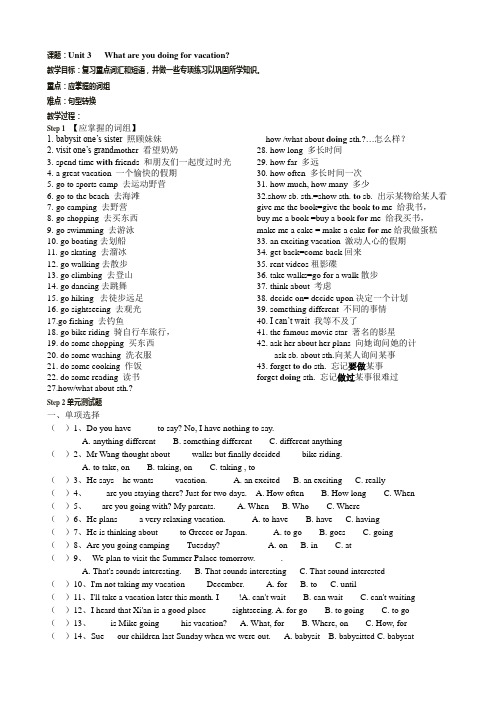
课题:Unit 3 What are you doing for vacation?教学目标:复习重点词汇和短语,并做一些专项练习以巩固所学知识。
重点:应掌握的词组难点:句型转换教学过程:Step 1【应掌握的词组】1. babysit one’s sister 照顾妹妹2. visit one’s grand mother 看望奶奶3. spend time with friends 和朋友们一起度过时光4. a great vacation 一个愉快的假期5. go to sports camp 去运动野营6. go to the beach 去海滩7. go camping 去野营8. go shopping 去买东西9. go swimming 去游泳10. go boating去划船11. go skating 去溜冰12. go walking去散步13. go climbing 去登山14. go dancing去跳舞15. go hiking 去徒步远足16. go sightseeing 去观光17.go fishing 去钓鱼18. go bike riding 骑自行车旅行,19. do some shopping 买东西20. do some washing 洗衣服21. do some cooking 作饭22. do some reading 读书27.how/what about sth.?how /what about doing sth.?…怎么样?28. how long 多长时间29. how far 多远30. how often 多长时间一次31. how much, how many 多少32.show sb. sth.=show sth. to sb. 出示某物给某人看give me the book=give the book to me 给我书,buy me a book =buy a book for me 给我买书,make me a cake = make a cake for me给我做蛋糕33. an exciting vacation 激动人心的假期34. get back=come back回来35. rent videos租影碟36. take walks=go for a walk散步37. think about 考虑38. decide on= decide upon决定一个计划39. something different 不同的事情40. I can’t wait我等不及了41. the famous movie star 著名的影星42. ask her about her plans 向她询问她的计ask sb. about sth.向某人询问某事43. forget to do sth. 忘记要做某事forget doing sth. 忘记做过某事很难过Step 2单元测试题一、单项选择()1、Do you have _____ to say? No, I have nothing to say.A. anything differentB. something differentC. different anything()2、Mr Wang thought about ____ walks but finally decided ____ bike riding.A. to take, onB. taking, onC. taking , to()3、He says he wants ____ vacation. A. an excited B. an exciting C. really()4、____ are you staying there? Just for two days. A. How often B. How long C. When ()5、___ are you going with? My parents. A. When B. Who C. Where()6、He plans ____ a very relaxing vacation. A. to have B. have C. having()7、He is thinking about ____ to Greece or Japan. A. to go B. goes C. going()8、Are you going camping ___ Tuesday? A. on B. in C. at()9、--We plan to visit the Summer Palace tomorrow. --____.A. That's sounds interesting.B. That sounds interestingC. That sound interested()10、I'm not taking my vacation ____ December. A. for B. to C. until()11、I'll take a vacation later this month. I ____!A. can't wait B. can wait C. can't waiting ()12、I heard that Xi'an is a good place _____ sightseeing. A. for go B. to going C. to go ()13、____ is Mike going ____ his vacation? A. What, for B. Where, on C. How, for ()14、Sue __ our children last Sunday when we were out. A. babysit B. babysitted C. babysat ()15、I hope ____ a doctor like my mother. A. being B. you to be C. to be()16、When most people mention Hollywood, they ____ movies.A. think over B. think about C. think of ()17、Mrs Green was an English teacher ____ loved renting vidios. A. who B. whom C. he()18、He decided ____ the position at the bank. A. on take B. to taking C. on taking()19、-- Is this book ____? --Yes, I'm very ____ in it.A. interesting, interestedB. interested, interestingC. interesting,interesting()20、--I'm going to Hawaii with my aunt this month for my holiday.-- ______.A. Have a good timeB. CongratulationsC. Best wishes for you.()21、He finished _____ before 10:00 yesterday. A. read B. reading C. to read()22、He plans _____ a very relaxing vacation. A. to have B. having C. to having()23、We ____ to Nanjing next month. A. will flying B. are flying C. fly()24、Next time don't forget ____ your son here. A. to take B. bring C. to bring()25、The headmster stopped ___ to me because there was a call for him.A.talking B. to talk C. to say二、句型转换1、We hope that we can visit Beijing.(同义). We hope _____ _____ Beijing.2、He decided to buy a new house.(同义). He decided ____ ____ a new house.3、We are staying for three weeks.(提问).____ _____ _____ you staying?4、Mary likes going shopping with her sister.(提问)____ ____ Mary like going shopping ____?5、To work in a hospital is interesting.(同义句)______ ______ interesting ______ work in a hospital.6、We are going to stay in Shanghai for a week.(对划线部分提问)______ ______ ______ you going to stay in Shanghai?7、I am going with my uncle.(对划线部分提问)______ _______ you going ______?8、There are many people there. They speak French.(连接为定语从句)There are many people there _____ ______ French.9、Our teacher often has much work to do.(同义)Our teacher often has ____ ____ ____ work to do.10、Don't forget to close the door when you leave the house.(同义)____ ____ close the door when you leave the house.。
人教新目标八年级英语上册 Unit3 复习课教学设计

人教新目标八年级英语上册Unit2 复习课教学设计一、词汇运用(10分)A)根据句意及汉语提示完成单词。
1. Linda is__________(相像的)to her mother.2. Nothing is too difficult if you put your__________(内心)into it.3. We didn’t win the match. We had to face the__________(事实).4. Parents always__________(关心)about their children.5. Class Five__________(获胜)in yesterday’s school ba sketball match.6. What do you __________(表示……的意思)by saying that?7. Many boy students show great _________(兴趣) in physics.8. __________(虽然) the girl often gets ill, she tries her best to study.10. You can ask the teacher for more _________(信息).答案: 1. similar 2. heart 3. fact 4. care 5. won6. mean7. interest8. Though / Although29. necessary 10. information二. 完成句子(每空词数不限)(10分)1.—How can I speak English_______(与你一样好), Rose?—Practice makes perfect.2. 我们知道学习数学和学习英语的方式是不同的。
We know that the ways of learning math are_________those of learning English.3. 只要天气好, 早晨我就锻炼。
英语人教版八年级上册U3复习课教学设计
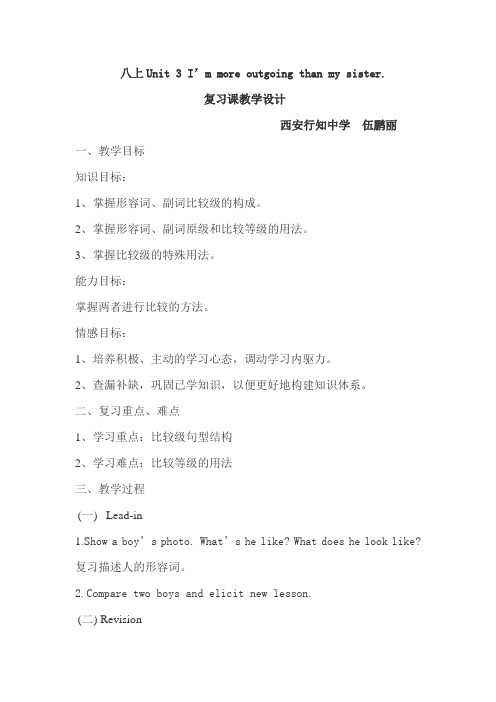
八上Unit 3 I’m more outgoing than my sister.复习课教学设计西安行知中学伍鹏丽一、教学目标知识目标:1、掌握形容词、副词比较级的构成。
2、掌握形容词、副词原级和比较等级的用法。
3、掌握比较级的特殊用法。
能力目标:掌握两者进行比较的方法。
情感目标:1、培养积极、主动的学习心态,调动学习内驱力。
2、查漏补缺,巩固已学知识,以便更好地构建知识体系。
二、复习重点、难点1、学习重点:比较级句型结构2、学习难点:比较等级的用法三、教学过程(一) Lead-in1.S how a boy’s photo. What’s he like? What does he look like? 复习描述人的形容词。
pare two boys and elicit new lesson.(二) Revision语法篇1. 复习形容词,副词的比较级的含义2.比较级的构成规则变化:①直:一般的词在原级后加 -er(比较级)加 -est(最高级)tall --- taller --- tallest②去:以字母e结尾的词在原级后加 -r(比较级)加-st(最高级late --- later --- latest③变:以辅音字母加y结尾的词,先把字母y改为i 再加 -er(比较级)加 -est(最高级)④双:以一个辅音字母结尾的重读闭音节词,先双写结尾辅音字母再加-er(比较级)加 -est(最高级)big --- bigger --- biggest⑤加:部分双音节词和多音节词,在原级前加more+原级(比较级)加most+原级(最高级)careful --- more careful --- most carefulimportant -- more important -- most important不规则变化:好good\well -- better -- best坏bad\ill\badly -- worse -- worst多many\much -- more -- most少little -- less -- least老old—older/elder—oldest/eldest远far -- farther/further -- farthest/furthest3.比较级的句式(1)A+动词+比较级+than+B。
人教八年级上册Unit-Unit3复习教案

(4)以辅音字母加y结尾的,变y为i加er
(5)多音节形容词变比较级,前面加more
6. both和as ...as...
Both表示两者都,否定形式为neither
As ...as...中间加形容词或副词的原级;第一个as是介词,第二个as是连词。
1.复合不定代词
2.动词过去式的规则变化和不规则变化
规则变化:(1)(2)(3)(4)
不规则变化
3.How often用法
4.频度副词
5.形容词的比较级
变化规则:(1)(2)(3)(4)
6.Both和as...as...
教学反思
教学重点
1、动词过去式的规则变化和不规则变化
2、形容词,副词的比较级和最高级的变化规则及不规则变化
教学方法
尝试教学法
课时安排
一个课时
教学过程
备注
Step 1 Review
The students read the words and texts in the text book loudly and then finish the list in the exercise book.
规则变化:
(1)一般情况下,加ed
(2)以不发音的e结尾的加d
(3)以重读闭音节结尾的,双写末尾那个字母,然后加ed
(4)以辅音字母加y结尾的,变y为i加ed
不规则变化:
课本后面的不规则变化表。
2.频度副词
Always, often, usually, sometimes,seldom, never
Step 4 Exercise
先给同学们时间讨论错题或不会的题,然后教师讲解他们不会的疑难问题。
- 1、下载文档前请自行甄别文档内容的完整性,平台不提供额外的编辑、内容补充、找答案等附加服务。
- 2、"仅部分预览"的文档,不可在线预览部分如存在完整性等问题,可反馈申请退款(可完整预览的文档不适用该条件!)。
- 3、如文档侵犯您的权益,请联系客服反馈,我们会尽快为您处理(人工客服工作时间:9:00-18:30)。
八上Unit 3 I’m more outgoing than my sister.
复习课教学设计
西安行知中学伍鹏丽一、教学目标
知识目标:
1、掌握形容词、副词比较级的构成。
2、掌握形容词、副词原级和比较等级的用法。
3、掌握比较级的特殊用法。
能力目标:
掌握两者进行比较的方法。
情感目标:
1、培养积极、主动的学习心态,调动学习内驱力。
2、查漏补缺,巩固已学知识,以便更好地构建知识体系。
二、复习重点、难点
1、学习重点:比较级句型结构
2、学习难点:比较等级的用法
三、教学过程
(一) Lead-in
1.S how a boy’s photo. What’s he like? What does he look like? 复习描述人的形容词。
pare two boys and elicit new lesson.
(二) Revision。
